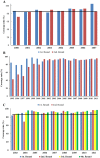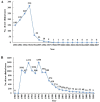Elimination of Onchocerciasis from Mexico
- PMID: 26161558
- PMCID: PMC4498594
- DOI: 10.1371/journal.pntd.0003922
Elimination of Onchocerciasis from Mexico
Abstract
Background: Mexico is one of the six countries formerly endemic for onchocerciasis in Latin America. Transmission has been interrupted in the three endemic foci of that country and mass drug distribution has ceased. Three years after mass drug distribution ended, post-treatment surveillance (PTS) surveys were undertaken which employed entomological indicators to check for transmission recrudescence.
Methodology/principal findings: In-depth entomologic assessments were performed in 18 communities in the three endemic foci of Mexico. None of the 108,212 Simulium ochraceum s.l. collected from the three foci were found to contain parasite DNA when tested by polymerase chain reaction-enzyme-linked immunosorbent assay (PCR-ELISA), resulting in a maximum upper bound of the 95% confidence interval (95%-ULCI) of the infective rate in the vectors of 0.035/2,000 flies examined. This is an order of magnitude below the threshold of a 95%-ULCI of less than one infective fly per 2,000 flies tested, the current entomological criterion for interruption of transmission developed by the international community. The point estimate of seasonal transmission potential (STP) was zero, and the upper bound of the 95% confidence interval for the STP ranged from 1.2 to 1.7 L3/person/season in the different foci. This value is below all previous estimates for the minimum transmission potential required to maintain the parasite population.
Conclusions/significance: The results from the in-depth entomological post treatment surveillance surveys strongly suggest that transmission has not resumed in the three foci of Mexico during the three years since the last distribution of ivermectin occurred; it was concluded that transmission remains undetectable without intervention, and Onchocerca volvulus has been eliminated from Mexico.
Conflict of interest statement
The authors have declared that no competing interests exist.
Figures




References
-
- Prost A (1986) The burden of blindness in adult males in the savanna villages of West Africa exposed to onchocerciasis. Trans R Soc Trop Med Hyg. 80: 525–7. - PubMed
-
- Zimmerman PA, Katholi CR, Wooten MC, Lang-Unnasch N, Unnasch TR (1994) Recent evolutionary history of American Onchocerca volvulus, based on analysis of a tandemly repeated DNA sequence family. Mol Biol Evol. 11: 384–92. - PubMed
-
- Expert Committee of the World Health Organization (1995) Onchocerciasis and its control. Geneva: World Health Organization, Report No.: 852. - PubMed
-
- Murdoch ME, Asuzu MC, Hagan M, Makunde WH, Ngoumou P, Ogbuagu KF, et al. (2002) Onchocerciasis: the clinical and epidemiological burden of skin disease in Africa. Ann Trop Med Parasitol. 96: 283–96. - PubMed
Publication types
MeSH terms
Substances
LinkOut - more resources
Full Text Sources
Other Literature Sources
Medical

